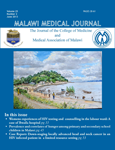
|
Malawi Medical Journal
College of Medicine, University of Malawi and Medical Association of Malawi
ISSN: 1995-7262
Vol. 23, No. 2, 2011, pp. 32-37
|
 Bioline Code: mm11011
Bioline Code: mm11011
Full paper language: English
Document type: Research Article
Document available free of charge
|
|
|
Malawi Medical Journal, Vol. 23, No. 2, 2011, pp. 32-37
| en |
HIV prevention awareness and practices among married couples in Malawi
Chirwa, Ellene; Malata, Address & Norr, Kathleen
Abstract
In this study we explored the level of awareness and practice on HIV prevention among married couples from selected communities in Malawi.
Methods
We carried out the study from October to December, 2008 in four communities, two each from Chiradzulu and Chikhwawa districts of Malawi. We conducted face-to-face in-depth interviews with 30 couples in each district using a semi-structured interview guide. The interviews lasted approximately 60-90 minutes. The husbands and wives were interviewed separately. The interviews were audio taped using a digital recorder. We wrote field notes during data collection and later reviewed them to provide insights into the data collection process. We computed descriptive statistics from the demographic data using SPSS version 16.0. We analyzed qualitative data using Atlas ti 5.0 computer software. The coded data generated themes and we present the themes in qualitative narration.
Results
The couples’ ages ranged from 20 to 53 years, the majority (52%) being in the 20-31year age group. Most of the couples (67%) attained only primary school education and 84% had been married only to the current partner. Most couples (83%) depended upon substance farming and 47% had been married for 3 to 9 years. The number of children per couple ranged from 1 to 10, most couples (83%) having between 1 and 5 children. All couples were aware of HIV prevention methods and talked about them in their marriages. Both wives and husbands initiated the discussions. Mutual fidelity and HIV testing were appropriate for couples to follow the HIV prevention methods. For most couples (54) there was mutual trust between husbands and wives, and members of only a few couples (6) doubted their partners’ ability to maintain mutual fidelity. Actual situations of marital infidelity were however detected among 25 couples and often involved the husbands. A few couples (5) had been tested for HIV. All couples did not favor the use of condoms with a marriage partner as an HIV prevention method.
Conclusion
The level of HIV prevention awareness among couples in Malawi is high and almost universal. However, there is low adoption of the HIV prevention methods among the couples because they are perceived to be couple unfriendly due to their incompatibility with the socio-cultural beliefs of the people. There is a need to target couples as units of intervention in the adoption of HIV prevention methods by rural communities.
|
| |
© Malawi Medical Journal
Alternative site location: http://revista.uft.edu.br/index.php/jbb/index
|
|
